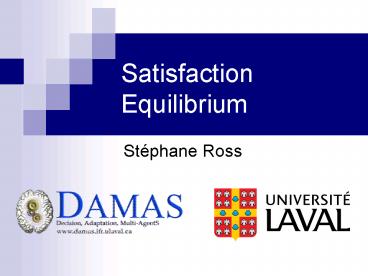Satisfaction Equilibrium - PowerPoint PPT Presentation
Title:
Satisfaction Equilibrium
Description:
Satisfaction Equilibrium. St phane Ross. Canadian AI 2006. 2 / 21. Problem ... Agents generally do not know the preferences (rewards) of their opponents ... – PowerPoint PPT presentation
Number of Views:80
Avg rating:3.0/5.0
Title: Satisfaction Equilibrium
1
Satisfaction Equilibrium
- Stéphane Ross
2
Problem
- In real life multiagent systems
- Agents generally do not know the preferences
(rewards) of their opponents - Agents may not observe the actions of their
opponents - In this context, most game theoretic solution
concepts are hardly applicable - We may try to define equilibrium concepts that
- do not require complete information
- are achievable through learning, over repeated
play
3
Plan
- Game model
- Satisfaction Equilibrium
- Satisfaction Equilibrium Learning
- Results
- Conclusion
- Questions
4
Presentation Plan
- Game model
- Satisfaction Equilibrium
- Satisfaction Equilibrium Learning
- Results
- Conclusion
- Questions
5
Game model
- Number of agents
- Joint action
space - Set of possible outcomes
- , the outcome function.
- , agent is reward function.
- Agent only knows , and .
- After each turn, every agent observes an outcome
.
6
Game model
- Observations
- The agents do not know the game matrix
- They are unable to compute best responses and
Nash Equilibrium. - They can only reason on their history of actions
and rewards.
a,b,c,d
7
Presentation Plan
- Game model
- Satisfaction Equilibrium
- Satisfaction Equilibrium Learning
- Results
- Conclusion
- Questions
8
Satisfaction Equilibrium
- Since the agents can only reason on their history
of payoff, we may adopt a satisfaction-based
reasoning - If an agent is satisfied by its current reward,
it should keep playing the same strategy - An unsatisfied agent may decide to change its
strategy according to some exploration function - An equilibrium will arise when all agents are
satisfied.
9
Satisfaction Equilibrium
- Formally
- is the satisfaction
function of agent - if (agent i is
satisfied) - if (agent i is not
satisfied) - is the satisfaction threshold of agent
- A joint strategy is a satisfaction equilibrium
if
10
Example
- Prisoners dilemma
- Possible satisfaction matrix
Dominant strategy D Nash Equilibrium
(D,D) Pareto-Optimal (C,C), (D,C), (C,D)
11
Satisfaction Equilibrium
- However, even if a satisfaction equilibrium
exists, it may be unreachable
12
Presentation Plan
- Game model
- Satisfaction Equilibrium
- Satisfaction Equilibrium Learning
- Results
- Conclusion
- Questions
13
Satisfaction Equilibrium Learning
- If the satisfaction thresholds are fixed, we only
need to apply the satisfaction-based reasoning - Choose a strategy randomly
- If satisfied, keep playing the same strategy
- Else choose a new strategy randomly
- We can also use other exploration functions which
favour actions that have not been explored often - Ex
14
Satisfaction Equilibrium Learning
- We use a simple update rule
- When the agent is satisfied, we increment its
satisfaction threshold by some variable - If the agent is unsatisfied, we decrement its
satisfaction threshold of - is multiplied by a factor each
turn such that it converges to 0 - We also use a limited history of our previous
satisfaction states and thresholds for each
action to bound the value of the satisfaction
threshold
15
Presentation Plan
- Game model
- Satisfaction Equilibrium
- Satisfaction Equilibrium Learning
- Results
- Conclusion
- Questions
16
Results
- Fixed satisfaction thresholds
- In simple games, we were always able to reach a
satisfaction equilibrium. - Using a biased exploration improves the speed of
convergence of the algorithm. - Learning the satisfaction thresholds
- We are generally able to learn the optimal
satisfaction equilibrium in simple games. - Using a biased exploration improves the
convergence percentage of the algorithm. - The factor and history size affects the
convergence of the algorithm and need to be
adjusted to get optimal results.
17
Results Prisoners dilemma
18
Presentation Plan
- Game model
- Satisfaction Equilibrium
- Satisfaction Equilibrium Learning
- Results
- Conclusion
- Questions
19
Conclusion
- It is possible to learn stable outcomes without
observing anything but our own rewards - Satisfaction equilibria can be defined on any
Pareto-Optimal solution. - However, satisfaction equilibria are not always
reachable - The proposed learning algorithms achieves good
performance in simple games - However, they require game-specific adjustments
for optimal performance
20
Conclusion
- For more information, you can consult my
publications at - http//www.damas.ift.ulaval.ca/ross
- Thank You!
21
Questions
- ?































